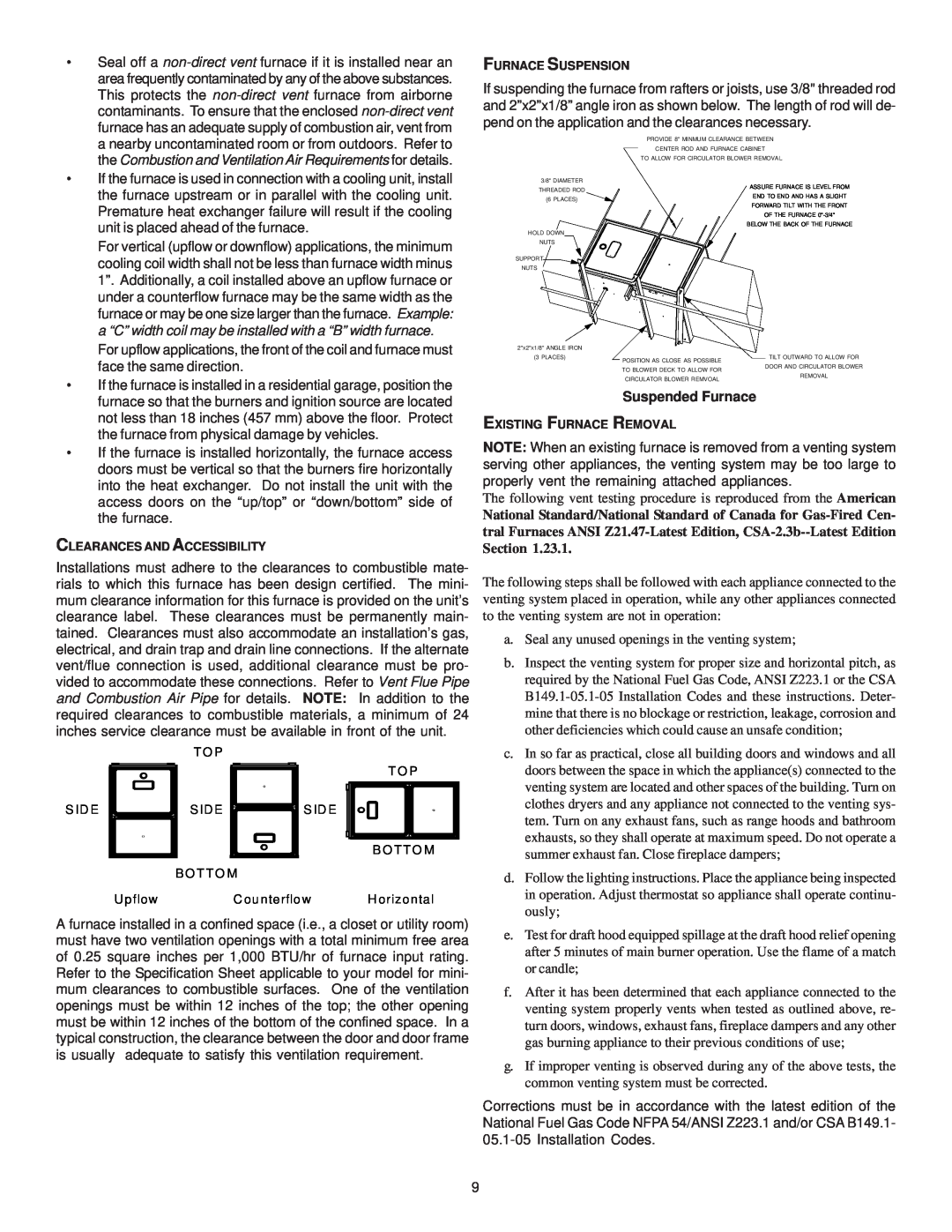
•Seal off a
•If the furnace is used in connection with a cooling unit, install the furnace upstream or in parallel with the cooling unit. Premature heat exchanger failure will result if the cooling unit is placed ahead of the furnace.
For vertical (upflow or downflow) applications, the minimum cooling coil width shall not be less than furnace width minus 1”. Additionally, a coil installed above an upflow furnace or under a counterflow furnace may be the same width as the furnace or may be one size larger than the furnace. Example: a “C” width coil may be installed with a “B” width furnace.
For upflow applications, the front of the coil and furnace must face the same direction.
•If the furnace is installed in a residential garage, position the furnace so that the burners and ignition source are located not less than 18 inches (457 mm) above the floor. Protect the furnace from physical damage by vehicles.
•If the furnace is installed horizontally, the furnace access doors must be vertical so that the burners fire horizontally into the heat exchanger. Do not install the unit with the access doors on the “up/top” or “down/bottom” side of the furnace.
CLEARANCES AND ACCESSIBILITY
Installations must adhere to the clearances to combustible mate- rials to which this furnace has been design certified. The mini- mum clearance information for this furnace is provided on the unit’s clearance label. These clearances must be permanently main- tained. Clearances must also accommodate an installation’s gas, electrical, and drain trap and drain line connections. If the alternate vent/flue connection is used, additional clearance must be pro- vided to accommodate these connections. Refer to Vent Flue Pipe and Combustion Air Pipe for details. NOTE: In addition to the required clearances to combustible materials, a minimum of 24 inches service clearance must be available in front of the unit.
T O P
|
|
|
|
| T O P | |
S ID E | S ID E |
| S ID E |
|
| |
|
|
| ||||
|
|
| ||||
|
|
|
|
|
|
|
|
|
|
|
| B O T T O M | |
|
| B O T TO M |
|
| ||
| U pflow |
| C ou nte rflo w | H orizon tal | ||
A furnace installed in a confined space (i.e., a closet or utility room) must have two ventilation openings with a total minimum free area of 0.25 square inches per 1,000 BTU/hr of furnace input rating. Refer to the Specification Sheet applicable to your model for mini- mum clearances to combustible surfaces. One of the ventilation openings must be within 12 inches of the top; the other opening must be within 12 inches of the bottom of the confined space. In a typical construction, the clearance between the door and door frame is usually adequate to satisfy this ventilation requirement.
FURNACE SUSPENSION
If suspending the furnace from rafters or joists, use 3/8" threaded rod and 2”x2”x1/8” angle iron as shown below. The length of rod will de- pend on the application and the clearances necessary.
PROVIDE 8" MINMUM CLEARANCE BETWEEN
CENTER ROD AND FURNACE CABINET
| TO ALLOW FOR CIRCULATOR BLOWER REMOVAL | |
3/8" DIAMETER | ASSURE FURNACE IS LEVEL FROM | |
THREADED ROD | ||
END TO END AND HAS A SLIGHT | ||
(6 PLACES) | ||
FORWARD TILT WITH THE FRONT | ||
| ||
| OF THE FURNACE | |
| BELOW THE BACK OF THE FURNACE | |
HOLD DOWN |
| |
NUTS |
| |
SUPPORT |
| |
NUTS |
|
2"X2"X1/8" ANGLE IRON |
|
|
(3 PLACES) | POSITION AS CLOSE AS POSSIBLE | TILT OUTWARD TO ALLOW FOR |
| DOOR AND CIRCULATOR BLOWER | |
| TO BLOWER DECK TO ALLOW FOR | |
| REMOVAL | |
| CIRCULATOR BLOWER REMVOAL | |
|
| |
| Suspended Furnace |
|
EXISTING FURNACE REMOVAL
NOTE: When an existing furnace is removed from a venting system serving other appliances, the venting system may be too large to properly vent the remaining attached appliances.
The following vent testing procedure is reproduced from the American
National Standard/National Standard of Canada for
The following steps shall be followed with each appliance connected to the venting system placed in operation, while any other appliances connected to the venting system are not in operation:
a.Seal any unused openings in the venting system;
b.Inspect the venting system for proper size and horizontal pitch, as required by the National Fuel Gas Code, ANSI Z223.1 or the CSA
c.In so far as practical, close all building doors and windows and all doors between the space in which the appliance(s) connected to the venting system are located and other spaces of the building. Turn on clothes dryers and any appliance not connected to the venting sys- tem. Turn on any exhaust fans, such as range hoods and bathroom exhausts, so they shall operate at maximum speed. Do not operate a summer exhaust fan. Close fireplace dampers;
d.Follow the lighting instructions. Place the appliance being inspected in operation. Adjust thermostat so appliance shall operate continu- ously;
e.Test for draft hood equipped spillage at the draft hood relief opening after 5 minutes of main burner operation. Use the flame of a match or candle;
f.After it has been determined that each appliance connected to the venting system properly vents when tested as outlined above, re- turn doors, windows, exhaust fans, fireplace dampers and any other gas burning appliance to their previous conditions of use;
g.If improper venting is observed during any of the above tests, the common venting system must be corrected.
Corrections must be in accordance with the latest edition of the National Fuel Gas Code NFPA 54/ANSI Z223.1 and/or CSA B149.1-
9
